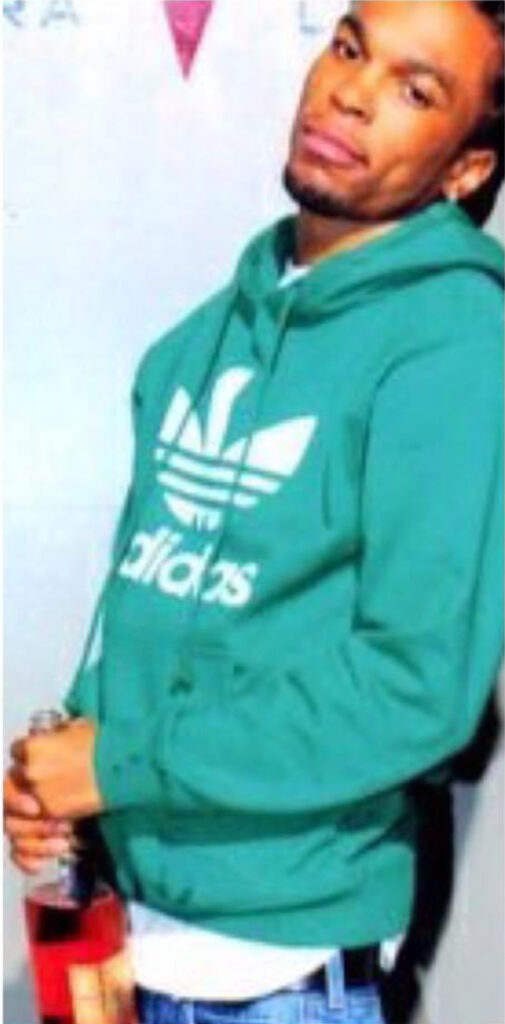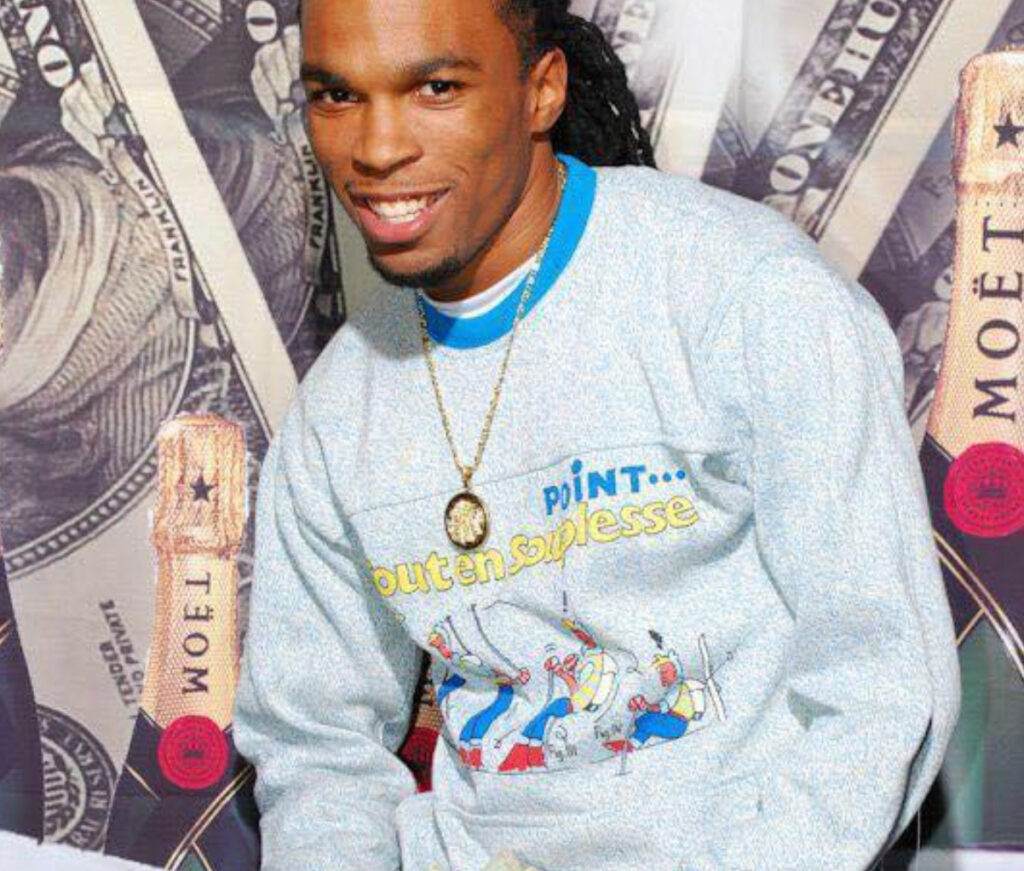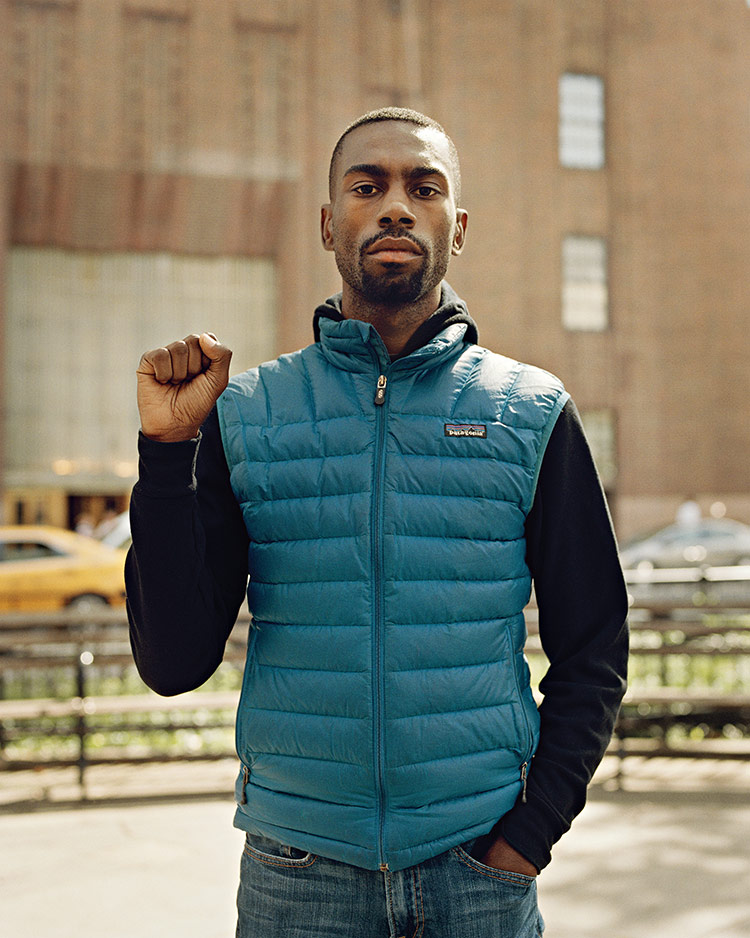DARREN SEALS
Darren was born on 15 May, 1987 in Ferguson, Missouri, USA and worked on the assembly line at Ford Motors.
Michael Brown’s death at the hands of Officer Darren Wilson
When when of his childhood friends, 18 year old Michael Brown, was shot dead by police officer Darren Wilson on 9 August , 2014, Darren galvanised and mobilised the neighbourhood to seek justice for Mike.
By all accounts, Darren was at the centre of key moments of the Ferguson protest, including embracing Mike’s mother on top of a car as she mourned the grand jury decision not to indict Wilson.
“She literally cried in my arms – it was like I felt her soul crying,” he told MTV News. “It’s a different type of crying. I’ve seen people crying, but she was really hurt. And it hurt me. It hurt all of us.”
He had been part of the protests over Brown’s death from the very first day, fellow activists said, and he was a devoted and charismatic protest leader.
“He didn’t go out to the national level like many of the organizers. He stayed home and tried to fix Ferguson first,” said Keith Rose, another St Louis activist.
Editor’s note: the following is written by dacorrespondent, who lives in Missouri and describes Darren as not a friend, but an acquaintance.

Darren criticised BLM
Darren had been criticizing the cooption of Ferguson activism since late 2014, detailing an internal division between the Ferguson movement and the national civil rights movement known as Black Lives Matter. At the heart of this division, wrote Seals, was the exploitation of black pain for profit – conducted not only by white media and NGOs, but by out-of-town black elites who seized on Ferguson as a stepping stone to glory.
In a May 24, 2015 post written in his typically blunt style, Seals excoriated what he saw as the hijacking of Ferguson, and the complicity that lies in silence. “BLACK DEATH IS A BUSINESS,” he wrote.
“Millions and millions flowing through the hands of these organizations in the name of Mike Brown yet we don’t see any of it coming into our community or being used to help our youth. I’ve been calling out this shit for months […] People see this as an opportunity to not only build a name but make bank at the expense of the lives of people like me.”
He was among few writers to clearly call out the division between the activists of the St. Louis region and the broader Black Lives Matter movement. In St. Louis, this division is talked about on the ground but rarely publicly. In the white-dominated mainstream media, where Ferguson is primarily spoken of as a symbol rather than a place where actual people live and suffer and fight, the fractiousness between local and national black movements has gone largely uncovered.
Darren was then found dead
On Tuesday 6 September, 2016, the Ferguson protest leader was found dead early in a car that had been set on fire. He had been shot, and St Louis County police said they were investigating his death as a homicide.
The 29-year-old’s death sent waves of shock and grief through the community of activists in Missouri who protested the police killing of unarmed black teenager Michael Brown in Ferguson in 2014.
“We have lost a great champion of civil rights in our community,” said Bassem Masri, a friend who had live-streamed the Ferguson protests, sometimes with Darren walking behind him to protect him as he filmed.
What Darren fought for
Darren’s forthrightness on the issue was and remains rare. If you are a black U.S. citizen fighting for black rights, you are the underdog – up against a white supremacist system in which brutality toward blacks is legitimized and practiced, especially by police. To expose internal fractures can appear to make the overall movement vulnerable, as it seems to play into the hands of white right-wing movements longing for the black rights movement to collapse. This power imbalance, combined with reluctance to criticize other black activists ostensibly fighting for the same broader goal, has made many who share Darren’s views wary of speaking them for fear of causing offense.
Having abandoned Ferguson as a place while embracing it as a brand, the national media largely focuses on the camera-friendly Black Lives Matter movement, which is how Seals ended up falsely being labeled a member of Black Lives Matter after he was killed.
Darren never cared if he offended. His blunt assertions that the movement had been hijacked by out of town activists and NGOs – as well as his misogynist and homophobic comments about other black protesters – offended many.
But his views on movement cooption were also embraced by many, particularly as local activists from Baton Rouge, Milwaukee, Baltimore and other cities where mass protests arose in reaction to police brutality began to express the same critiques. This is our city, our struggle, and we already have groups who have been fighting this struggle for years, they noted, balking at the sudden arrival of celebrity activists and NGOs who had ignored their day-to-day plight until the cameras arrived.
Cameras were never Darren’s concern: the streets of St. Louis were. St. Louisans had known Darren since August 9, 2014, the day Mike Brown was killed by Officer Darren Wilson in Ferguson. They knew him for confronting cops like police union official Jeff Roorda, who flaunted his “I Am Darren Wilson” bracelet shortly after Brown’s death, and for condemning the out-of-town protesters who, thanks to media exposure, became the voices of a movement they did not start.
On one infamous occasion in early 2015, Seals slapped DeRay McKesson, a Minneapolis-based school administrator who arrived in Ferguson over a week after the protests began, but became the face of Ferguson coverage, landing a New York Times Magazine cover applauding his efforts in May 2015. Seals accused McKesson – who had by then long left St. Louis behind – of hijacking the Ferguson movement and neglecting the cash-strapped local activists still being targeted, jailed, and fined by the police.
After the slap heard around St. Louis, both activists continued to fight for black rights, but in very different ways. McKesson went on to meet with elites in Aspen and DC and unsuccessfully run for mayor of Baltimore. Darren went back to his job on the General Motors assembly line, and tried to raise money for underprivileged black children in St. Louis.

Many disapproved of Darren’s physical aggression or choice of Mckesson as a target, but few in the Ferguson movement did not understand the pain behind it – the pain of living in a region overexposed and ignored at the same time. The pain of black death turned into a business, as Seals saw it.
People accused Darren of being jealous, but he was not – he was angry. He wanted a black-run, self-determined movement rooted in local St. Louis concerns. He did not long for validation from white elites. He was furious at the exploitation of his community by outsiders for profit, and fiercely protective of the Brown family.

St. Louis was what Darren Seals emphasized, over and over, until the day he died – no matter how badly some wanted him to stop. He documented St. Louis’s hopes and hijacking, along with BGyrl and other black St. Louisans frustrated that a select group of Ferguson protesters – whom BGyrl and Seals called “ACTORvists” – had left St. Louis to travel the country giving talks and working for NGOs and making money, while the vast majority of local protesters were in jail, facing court dates, losing jobs, borderline homeless or actually homeless.
Seals was also the activist who quietly but firmly confronted police union official Jeff Roorda for wearing a bracelet that said “I am Darren Wilson” at a city meeting.
“A lot of the protesters were very mean and hateful and disrespectful, and he was not.”
Roorda said that confrontation was a “mature conversation” and called Seals’ death a tragedy.
“He was not hateful,” Roorda said. “He was angry about what he thought was going on in the world around him and he was passionate about that,” Roorda said.
Did you know who Darren Seals was before he died? If you live in St. Louis, and were involved in the Ferguson protests, you did. On Facebook Here’s Darren’s Facebook page…and on Twitter, …and here’s his Twitter feed, where he posted as @KingDSeals.
Many disapproved, but few in the Ferguson movement did not understand the pain behind Seals’ choices – the pain of living in a region overexposed and ignored at the same time

Who Seals was
St. Louis is a sprawling metropolis that feels like a small town because many tend to know someone who has been murdered, or know their relatives or friends. Our connections are solidified in bereavement, and it is painful to write of Darren Seals as yet another name on a long list of people who left us too soon.
Seals was not my friend, but he was an acquaintance. I had met him a few times at protests, we followed each other on Twitter, and we shared close mutual friends. One of those friends is BGyrl, a St. Louis writer who works in the hip-hop industry.
On September 6, I was with my friend Umar Lee, who also covered the protests in Ferguson, when BGyrl sent me a text:
“Someone killed Darren Seals last night,” she wrote. I read the text out loud.
“It’s fucking St. Louis,” Umar said, shaking his head at yet another violent death, another voice silenced, and the horrifying familiarity of it all. Another of my friends, upon hearing about Seals, summed it up: “St. Louis is not where people live, it’s where we wait to die.”
But there was a deeper point in Umar’s simple statement. St. Louis is not a place to be trifled with. If you try to ignore its political reality, and St. Louis will rise up to remind you – with its anger, with its blood, haunting hypocrites like a ghost.
According to Seals, the media bonanza opened the door for others to capitalize on the Ferguson brand – to make “black death a business”
The Ferguson protests prompted a lot of national talk, but little real local reform. Black residents continue to be killed by police without repercussions, and majority black areas of the region remain disproportionately poor and strapped for resources.
According to Seals, the media bonanza opened the door for others to capitalize on the Ferguson brand – to make “black death a business.” All over the country, organizations held panel discussions on Ferguson. But they rarely included anyone from St Louis, and almost never black men who grew up poor and lacked a college education, despite that it was men like this who stood up to fight for Mike Brown from day one.
And it was in Seals’ arms that Mike Brown’s mother wept.
What Seals claimed
Here we arrive at what Seals was investigating before he died. He, along with me and others in St Louis, had been attempting to follow the Ferguson money trail for years, but we have not yet found clear answers into how or whether funding by outside and local groups was allocated. However, the discrepancy between who is paid to represent Ferguson to the broader public and who lives day-to-day with the problems of Ferguson is readily apparent.
On August 27, MTV convened a typical “Ferguson” panel. It consisted of five black speakers as well as a white woman named Holly Fetter, who was listed as an “ally organizer”. No one who lived in or near Ferguson was invited to speak about Ferguson.
“What is an ‘ally organizer’?” I texted BGyrl.
“Ferguson without Ferguson again,” she texted back – but then we took a closer look.
Fetter works at an organization called Resource Generation, You can read more about Resource Generation here.a charity run by young people between ages 18 and 35 – sons and daughters of wealthy families who say they want to use their inheritance for the public good. The organization admits it has never been in contact with Brown’s family, despite raising money in their name, and claims to have given $200,000 to “support frontline organizing efforts in Ferguson, Missouri” between October and December 2014. Resource Generation also claims to have invested over one million dollars in “black-led organizing” over 2015.
The organization admits it has never been in contact with Brown’s family, despite raising money in their name
Baffled by this discrepancy between the charity’s claims and the poverty we see around us every day, BGyrl and I looked at a Resource Generation map Here’s Resource Generation’s own map showing how they allocated funds.showing how their funds are distributed around the country. It turns out that very little had been allocated to St. Louis, one of the alleged targets of funding.
BGyrl posted information about the group on bgyrlforlife, You can view Bgyrl’s Facebook page here.her Facebook page, and on the website Hands Up Don’t Shoot. Go to The Hands Up Don’t Shoot website.She also posted a document View the document BGyrl posted.from a group called ABFE, written in late 2014, claiming that a number of initiatives in St. Louis would be funded to further black rights. Among their promises were economic support for Ferguson protesters, treatment for PTSD, and the launch of St. Louis independent media.
We don’t know where all this money went. What we do know is that if any of these initiatives were funded, there is little evidence of it on the ground. St. Louis activism remains chronically underfunded, resource deprivation in majority black areas is high, and the region’s problems Here’s a piece I wrote on the region for The Common Reader.are ignored by the national media until there is a crisis – like, say, the death of Darren Seals.
What Seals wanted
One of the last things Seals tweeted before he was murdered was a link to a video interview BGyrl Watch the interview with BGyrl here.did. She was asked to do this interview after posting the documents on the NGOs mentioned above. Seals said it was the “only interview telling the truth about Black Lives Matter and the Ferguson hijacking.”
It is worth watching BGyrl’s interview if you want the other side of the Ferguson story – the St. Louis perspective. It is worth going to Seals’ social media accounts and reading his own words. These words are not always easy to hear. His language was at times homophobic and misogynist; his critiques of other activists were often viewed as mean-spirited and unfair.
But his overall argument – that black communities in St. Louis have been abandoned by a national movement that gained prominence by dropping the Ferguson name – is hard to dispute.
What the murder of Darren Seals clearly shows is that there is no excuse for ignoring the locals whose everyday suffering represents the reality of what happens here. There is no excuse for the apathy toward and abandonment of St Louis’s black community that predated the killing of Brown and continues to this day.
“Sleep is the new woke,” Seals wrote See Darren’s final tweet here.sarcastically before he died, referring to the hypocrisy he saw in Black Lives Matter and other black rights groups. I did not know Seals well, but I know he would have wanted you to read his words. He wanted people to listen.
He wanted people to wake up.
Sources: the correspondent.com, The Guardian.




